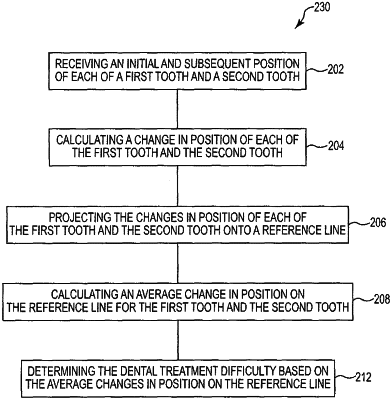| CPC A61C 7/002 (2013.01) [G16H 15/00 (2018.01); G16H 50/50 (2018.01)] | 19 Claims |

|
1. A computing device implemented method of digital treatment planning, the method comprising: processing a scan of a patient's dentition to derive a virtual three-dimensional (3D) model of the patient's dentition, wherein the virtual 3D model corresponds to an initial dental model of a patient's arch including a plurality of teeth in initial positions; generating a digital treatment plan for moving the plurality of teeth from the initial positions toward subsequent positions of a target dental model of the patient's arch;
calculating tooth position changes from the initial dental model to the target dental model in a mouth quadrant of the patient's dentition by determining a first change in position in a mesial-distal direction of a first tooth from a first initial position toward a first subsequent position, and a second change in position in the mesial-distal direction of a second tooth from a second initial position toward a second subsequent position, wherein the first change in position is determined by projecting a first distance between the first initial position and the first subsequent position onto an arch line of the initial dental model of the patient's arch, and wherein the second change in position is determined by projecting a second distance between the second initial position and the second subsequent position onto the arch line of the initial dental model of the patient's arch;
calculating an average change in position for the mouth quadrant, wherein the average change in position is calculated using the first change in position and the the second change in position;
determining a treatment difficulty of anterior-posterior (A-P) correction for the mouth quadrant based on the calculated average change in position, wherein a greater average change in position is associated with a higher treatment difficulty of A-P correction;
and adjusting the digital treatment plan so that a provider skill level meets or exceeds the treatment difficulty of A-P correction, wherein the adjusted digital treatment plan includes the used of dental applicances.
|